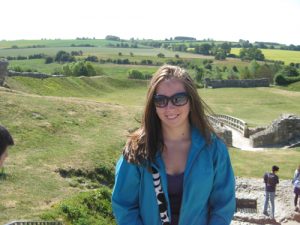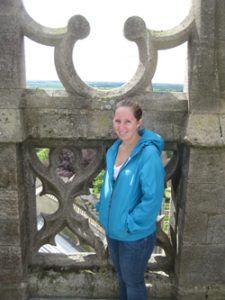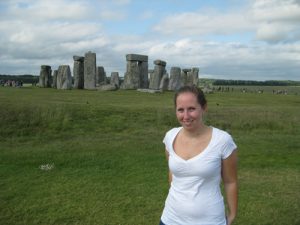Student Reports: Jasmine Kelley, England, 2011
Visiting London, Oxford, Cambridge, Windsor, Stonehenge & Canterbury
June 3, 2011

While we were in England, we visited various historic locations throughout London, Oxford, Cambridge, Windsor, Stonehenge, and Canterbury. I also got the opportunity to go to Amsterdam in the Netherlands while I was abroad. I enjoyed seeing the beautiful architecture on the Anglican churches, but my favorite parts were the Ely Cathedral Octagon, the Stonehenge visit, and the science buildings at Cambridge University. The Ely Cathedral Octagon is an octagon platform that is suspended over a hundred feet in the air above the center of the cathedral. This was built using only logs and wooden pegs before calculus had been invented. Somehow they were able to determine the correct angles so that the natural forces of tension and compression would keep the structure solid. I can’t imagine working this problem in Statics, let alone building it. I’ve always wanted to see Stonehenge, and I stood before it in awe for awhile. It’s easy to imagine this being made in modern times, but to think that it was started in 3000 B.C. before cranes were even thought of is mind blowing.

Some of the greatest scientific minds (Darwin, Thomson, Watson, Crick, etc.) attended or taught at Cambridge University, so we were able to walk through the town and point out where DNA was discovered, where the atom was split, etc. This was a little unreal because I had always thought of these things as being a given, but seeing the places where the discoveries took place was inspiring.
Traveling through foreign countries stretched my communication skills, but I didn’t have any trouble finding someone to help me get where I needed to go. I also realized that many of my preconceptions about the British (and later the Dutch) were completely unfounded. The British weren’t as I expected which taught me to take all opinions with a grain of salt and observe before I assumed. This will greatly help when I enter the engineering world, as many of our downfalls are brought on by incorrect assumptions. After studying abroad, I feel much more comfortable interacting with people from other nations. Once I acknowledged the differences between those who are American and those who are British, I began to see all of the similarities and look past the biases I had once held.

Thursday, May 12, 2011
After a quick breakfast in the basement of the hotel, the group headed off to the British Museum at quick a brisk pace (it’s very hard to keep up with Dr. Heffernan if you have short little legs, like I do). Once again, we took the Underground, and I began to marvel at the way the British look. I still could not identify someone as British until I heard their accent—there were just so many different people here. I guess the United States is similar, but it seems like we all fit the same profile, or are always rushing around trying to do ten different things at the same time. The British don’t seem to have many similarities, but our group stuck out like sore thumbs since we wandered around in a group of seventeen people.
When we got to the British Museum, we started off by seeing the Rosetta Stone. I knew what the stone was (other than the computer program to help you learn another language), but I thought it would be much smaller. The stone was surrounded by lots of tourists each trying to get a perfect picture (which I wasn’t able to do). It was very different to think about a time before there was the alphabet that I’m familiar with, much less see languages that are much, much older. I never thought I would see something that tells such a history of the world and its languages. We then went to the see the Parthenon Galleries, which were much more detailed then I had thought they would be. I could actually see the veins in the horse’s leg and the outline of the ribs on the humans. It was also very interesting to see the story that the scenes told about the sacrifices and how the gods and goddesses were identified.
The next exhibit we looked at was that of the Sutton Hoo. I read Beowulf in high school, and none of it sank in because I had nothing to relate it too. Seeing the actual objects made it more realistic and helped me to understand the story more. Dr. Heffernan then took us to the Warren Cup—a very evocative cup showing male sex scenes. I had never heard of this apparently famous cup, but I can now understand why it isn’t talked about much in school. Finally, we looked at the mummy exhibits, another thing from history that I never thought I would get to see. As a child, I was a little fascinated with Egypt and mummies so it was really neat to see the mummies in person instead of in a textbook. After the British Museum, we went to the British Library to see the Magna Carta, the Codex Sinaiticus, and other old manuscripts. Once again, I never thought I would see these things, so it took me awhile to take it all in (and I still don’t think I have).
The group then dispersed to do whatever we wanted, so Alex, Samantha, and I just wandered around London and eventually saw the National Portrait Gallery, Trafalger Square, and the theater district. I was happy to just wander and take in as much as I could without having to go on a tour and just being able to see what I could see at my own pace. I was especially excited by the Olympic countdown and the giant ship in a bottle!
We then went to eat at a small restaurant, which is very different from eating at one in the United States. At home, servers work for tips so they’re really friendly and try to get as many people in and out as they can, but here waitresses don’t expect a tip, so they move pretty slow. They’re generally polite to you, but it takes forever to eat and especially to get the tab (which is never broken up). They also look at you funny when you ask for water (better known as tap water), and the cups are really small with no refills. I know one would make more money this way, but I don’t see why people put up with it; although, I have noticed that the British don’t seem to hydrate themselves like most Americans do.
After dinner, we trekked to the Globe Theater and got to walk over one of the bridges in the Harry Potter movie (super exciting!). The Globe was weird. In high school, I had a teacher obsessed with everything Shakespeare, but I just didn’t get it. The theater itself didn’t seem to be laid out very well because it looked like only one section would have a really good view, but the acoustics were very nice. Watching the play was a lot funnier than I thought it would be for Hamlet, which always seemed so somber. After watching it, I always have a better idea of how Shakespeare used stage directions and signals to make an impression on the audience—something that doesn’t translate well in just reading it.